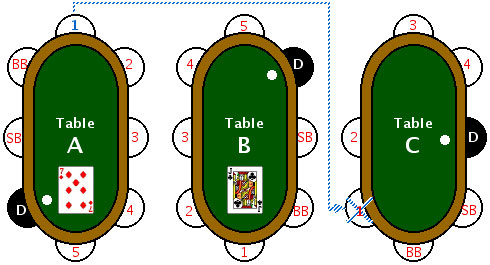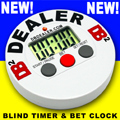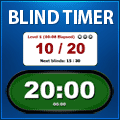|
|
Moving Poker Players Between TablesHow to move poker playersIf you have more than one table in play, you must balance the number of players sitting at each table. You want to avoid having too many players at one table, while not enough players at another table. For home tournaments consisting of only a couple tables, you should probably balance the tables when the number of players differs by two or more between any tables. If the number of players differs by two or more between any tables, one player must move from the highest-populated table to the lowest-populated table. This will ensure a balanced number of players between all tables. You want to avoid giving a player an advantage or disadvantage when being moved. An advantage would be moving a player, who was just about to pay a big blind, to a table where he is furthest away from paying a big blind. A disadvantage would be moving a player, who has just paid a big blind, to a table where he must once again pay a big blind. Method 1 - Move the player in the same seatThis method of moving players ensures that a moved player is never forced to post two big or small blinds in a row or allowed to deal two hands in a row. In addition, the moved player can simply fill the empty seat vacated by the eliminated player. When a player is eliminated and a move must be made, the player ‘playing a hand’ in the same position (seat), relative to the button, at the highest-populated table must move to the eliminated player’s seat. In other words - if the player who busted out was four seats left of the button, move the player from the other table who is sitting four seats left of the button. The move must occur before the next hand is dealt, or the button is advanced, at any table. For the purpose of this rule, a player is ‘playing a hand’ once all the blinds/antes have been posted and the dealer has begun shuffling (riffles the deck). Moving occurs at the conclusion of all hands presently being played at all tables. If several players must be moved at the same time, begin with the eliminated player, at the lowest populated table, closest to the left of the button. When forced to choose between removing a player from two equally populated tables, one card will be dealt (by the lower populated table’s dealer) to each of the two tables in question. The low-carded table will move a player. A moved player will be dealt a hand at the start of the next deal and assume any obligation of the new seat including the posting of a blind or dealing.
Method 2 - Move the button playerAn alternate method is to move the player at the button from the high table to the seat to the right of the button at the low table. Method 3 - Move the big blind playerAn alternate method is to move the player from the high table who will be the big blind on the next hand. This player moves to the empty seat closest (clockwise) to the big blind at the low table. How to combine tablesIf you have more than one table in play, you must decide how you will reduce tables as players are eliminated. The easiest method to combine tables is at preset times as players are eliminated from the tournament. For example - you will go from 3 tables down to 2 tables when there are 20 players remaining in the tournament and you will go down from 2 tables to 1 table when there are 10 players remaining. Adjust these numbers to accommodate the size of your poker tables and whether or not you will have a dedicated dealer occupying a seat at the table. You might have one large poker table that can accommodate 10 players and two smaller tables that can only accommodate 6 players each. You are hosting a tournament of 22 players and they will be seated 10 + 6 + 6 per table. You will go down to two tables when there are 16 players remaining in your tournament and you will go down to one (final) table when there are 10 players remaining. You must decide how you will seat your players when reducing tables ...
Mid-Tournament seatingIf you are re-seating all your players at new tables, you might want to attempt to balance out the total number of chips at each table. Although this ensures a bit more fairness, in that all tables will have the same approximate number of chips, it can lead to problems in deciding who sits at what table. Some tournament directors will use a method such as this ... Largest stack moves to Table 1 Seating the final tableIf you have more than one table in play, make sure that you announce how you will combine tables and how you will seat the final table. The easiest way to seat your final table is to draw for new seats when you have 10 players remaining in your tournament. All 10 remaining players choose a card and sit in the appropriate seat at the final table. The number of players at your final table will depend on the size of your poker table, but nine or ten players is probably best. You should probably have a dedicated dealer at your final table, and this dealer will take up one seat at your table. If you have been playing with 10 players at each table and using a dealer/player, you should probably go down to 9 players plus a dedicated dealer for your final table. Finding someone who is willing to deal at the final table should not be a problem since you will have numerous busted out players watching the tournament. Some players might complain about an unequal number of chips at the final table. Some players might have a great number of chips because they came from tables where the action was wild and there were many rebuys. Other players might have come from more conservative tables, where there were few rebuys and the total number of chips on the table remained low. This is the luck of the draw - all players are randomly seated at the beginning of the tournament. Every final table will consist of players with a wide range of chips. If you are holding a large tournament, you might consider paying out all the players who make the final table. Payout the final nine or ten players and make a big deal out of reaching the final table! Playing hand-for-handYou should consider playing hand-for-hand towards the end of your tourney when you are about to seat the final table. For instance, if you have one table of six players and another table of five players and you will seat ten players at the final table ... the next player eliminated will not make the final table. Some players may try to stall (slow down the game) at their own table in the hope that the other table will play more hands and a player from the other table will be eliminated. You must be on guard for the same delaying tactic if you have a large tourney and are paying out, for instance, the top twenty players. If you have three tables of eight players remaining ... some of those players might try to stall in the hopes of having players from other tables go broke first. For these reasons, you should probably play hand-for-hand at all your tables when you are in a bubble situation. Playing hand-for-hand means that you do not start a new hand at any table until every other table is also ready to start a new hand - every table waits until all the other tables are ready to deal. This will ensure that all tables play the same number of hands. Shotgun tournamentAnother method to move poker players is ... to not move them! A shotgun tournament means that each table will play internally until there is only one player remaining at each table. No players are moved from table to table. Each table winner is then seated to form the final table. The obvious advantage to using a shotgun format is that you don't have to worry about balancing players between tables - no one gets moved until you seat the final table. One disadvantage of a shotgun tournament is that one table might have a winner after two hours of play while another table takes four hours. Another disadvantage is that you might have the three or four best players all sitting at the same table - only one of those players will advance. Players might arrive at the final table with differing numbers of chips. Some shotgun tournaments ensure that all players start the final table with equal amounts of chips, while other shotgun tournaments allow each player to keep as many chips as they have earned throughout the tournament. Shotgun variationYou can use a variation of the shotgun tournament format by playing each table internally until there are only a few players remaining at each table. For instance, if you have a tournament of 27 players - you could seat 3 tables of 9 players and have each table play internally to itself until there are only 3 players remaining at each table. Those 9 players would then form the final table.
|
Online Poker Guide
Hand Converter
Holdem strategy
Freeroll tournaments
Poker calculator
Online poker
Poker rooms
> poker pokeren
> iDeal poker
> online casino
> iDeal casino
> casino casinos
> casino bonus
Get Bonus code Titan Poker, and full tilt poker referral code or max bonus to the full tilt referral code. Best ultimate bet referral code sign up bonus doyles room promo code or poker host bonus code
























